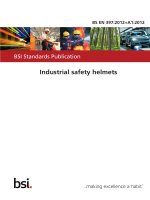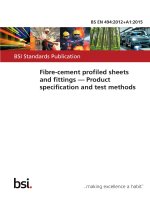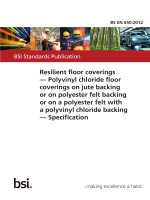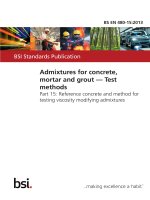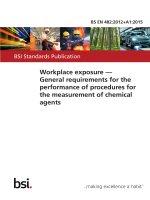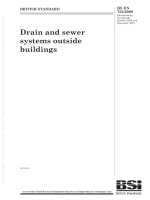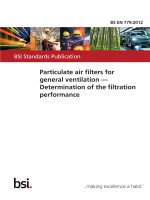Bsi bs en 61982 2012 (2013)
Bạn đang xem bản rút gọn của tài liệu. Xem và tải ngay bản đầy đủ của tài liệu tại đây (3.67 MB, 46 trang )
BS EN 61982:2012
Incorporating corrigendum February 2013
BSI Standards Publication
Secondary batteries (except
lithium) for the propulsion
of electric road vehicles —
Performance and endurance
tests
BS EN 61982:2012
BRITISH STANDARD
National foreword
This British Standard is the UK implementation of EN 61982:2012. It
is identical to IEC 61982:2012. It supersedes BS EN 61982-1:2006,
BS EN 61982-2:2002 and BS EN 61982-3:2001 which are withdrawn.
The UK participation in its preparation was entrusted to Technical
Committee PEL/21, Secondary cells and batteries.
A list of organizations represented on this committee can be
obtained on request to its secretary.
This publication does not purport to include all the necessary
provisions of a contract. Users are responsible for its correct
application.
© The British Standards Institution 2013.
Published by BSI Standards Limited 2013
ISBN 978 0 580 81667 3
ICS 29.220.20
Compliance with a British Standard cannot confer immunity from
legal obligations.
This British Standard was published under the authority of the
Standards Policy and Strategy Committee on 28 February 2013.
Amendments/corrigenda issued since publication
Date
Text affected
28 February 2013 IEC text inserted
EUROPEAN STANDARD
EN 61982
NORME EUROPÉENNE
October 2012
EUROPÄISCHE NORM
ICS 29.220.20
Supersedes EN 61982-1:2006, EN 61982-2:2002 + corr. Dec.2002, EN 61982-3:2001
English version
Secondary batteries (except lithium) for the propulsion
of electric road vehicles Performance and endurance tests
(IEC 61982:2012)
Accumulateurs (excepté lithium)
pour la propulsion des véhicules
routiers électriques Essais de performance et d'endurance
(CEI 61982:2012)
Sekundärbatterien (ausgenommen
Lithium-Batterien) für den Antrieb
von Elektrostraßenfahrzeugen Kapazitäts- und Lebensdauerprüfungen
(IEC 61982:2012)
This European Standard was approved by CENELEC on 2012-06-01. CENELEC members are bound to comply
with the CEN/CENELEC Internal Regulations which stipulate the conditions for giving this European Standard
the status of a national standard without any alteration.
Up-to-date lists and bibliographical references concerning such national standards may be obtained on
application to the CEN-CENELEC Management Centre or to any CENELEC member.
This European Standard exists in three official versions (English, French, German). A version in any other
language made by translation under the responsibility of a CENELEC member into its own language and notified
to the CEN-CENELEC Management Centre has the same status as the official versions.
CENELEC members are the national electrotechnical committees of Austria, Belgium, Bulgaria, Croatia, Cyprus,
the Czech Republic, Denmark, Estonia, Finland, Former Yugoslav Republic of Macedonia, France, Germany,
Greece, Hungary, Iceland, Ireland, Italy, Latvia, Lithuania, Luxembourg, Malta, the Netherlands, Norway, Poland,
Portugal, Romania, Slovakia, Slovenia, Spain, Sweden, Switzerland, Turkey and the United Kingdom.
CENELEC
European Committee for Electrotechnical Standardization
Comité Européen de Normalisation Electrotechnique
Europäisches Komitee für Elektrotechnische Normung
Management Centre: Avenue Marnix 17, B - 1000 Brussels
© 2012 CENELEC -
All rights of exploitation in any form and by any means reserved worldwide for CENELEC members.
Ref. No. EN 61982:2012 E
BS EN 61982:2012
EN 61982:2012 (E)
-2-
Foreword
The text of document 21/775/FDIS, future edition 1 of IEC 61982, prepared by IEC/TC 21 "Secondary
cells and batteries" was submitted to the IEC-CENELEC parallel vote and approved by CENELEC as
EN 61982:2012.
The following dates are fixed:
•
latest date by which the document has
to be implemented at national level by
publication of an identical national
standard or by endorsement
(dop)
2013-04-19
•
latest date by which the national
standards conflicting with the
document have to be withdrawn
(dow)
2015-06-01
This document supersedes EN 61982-1:2006, EN 61982-2:2002 + corrigendum December 2002 and
EN 61982-3:2001.
EN 61982:2012 includes the following significant technical changes with respect to EN 61982-1:2006,
EN 61982-2:2002 and EN 61982-3:2001:
-
clarification of the scope;
-
update of some tests, and
-
addition of the Annex A dealing with NiMh batteries for the propulsion of hybrid electric vehicles.
Attention is drawn to the possibility that some of the elements of this document may be the subject of
patent rights. CENELEC [and/or CEN] shall not be held responsible for identifying any or all such
patent rights.
Endorsement notice
The text of the International Standard IEC 61982:2012 was approved by CENELEC as a European
Standard without any modification.
In the official version, for Bibliography, the following notes have to be added for the standards indicated:
IEC 60051 series
NOTE
Harmonized as EN 60051 series (not modified).
IEC 60254-1:2005
NOTE
Harmonized as EN 60254-1:2005 (not modified).
IEC 60359
NOTE
Harmonized as EN 60359.
IEC 62660-1:2010
NOTE
Harmonized as EN 62660-1:2011 (not modified).
IEC 62660-2:2010
NOTE
Harmonized as EN 62660-2:2011 (not modified).
BS EN 61982:2012
EN 61982:2012 (E)
-3-
Annex ZA
(normative)
Normative references to international publications
with their corresponding European publications
The following documents, in whole or in part, are normatively referenced in this document and are
indispensable for its application. For dated references, only the edition cited applies. For undated
references, the latest edition of the referenced document (including any amendments) applies.
NOTE When an international publication has been modified by common modifications, indicated by (mod), the relevant EN/HD
applies.
Publication
Year
Title
EN/HD
Year
IEC 60050-482
2004
International Electrotechnical Vocabulary
(IEV) Part 482: Primary and secondary cells
and batteries
-
-
IEC 61434
-
Secondary cells and batteries containing
alkaline or other non-acid electrolytes Guide to the designation of current in
alkaline secondary cell and battery
standards
EN 61434
-
BS EN 61982:2012
61982 © IEC: 2012
–2–
CONTENTS
FOREWORD ........................................................................................................................... 5
INTRODUCTION ..................................................................................................................... 7
1
Scope ............................................................................................................................... 8
2
Normative references ....................................................................................................... 8
3
Terms and definitions ....................................................................................................... 8
4
General test requirements ................................................................................................ 9
4.1
5
Accuracy of measuring instruments ......................................................................... 9
4.1.1 Electrical measuring instruments ................................................................. 9
4.1.2 Temperature measurement ........................................................................ 10
4.1.3 Electrolyte density measurement of vented lead-acid batteries .................. 10
4.1.4 Tolerance .................................................................................................. 10
4.2 General provisions ................................................................................................ 10
4.2.1 Current slew rate ....................................................................................... 10
4.2.2 Temperature – electrolyte accessible......................................................... 10
4.2.3 Temperature – electrolyte not accessible ................................................... 11
4.2.4 Electrolyte density readings of vented lead-acid batteries .......................... 11
4.2.5 Mechanical support ................................................................................... 11
4.3 Test samples ......................................................................................................... 11
4.4 Test temperature ................................................................................................... 11
4.4.1 Test temperature for type testing ............................................................... 11
4.4.2 Operation of BMS ...................................................................................... 12
4.5 Charging and rest after charge .............................................................................. 12
4.6 Conditioning .......................................................................................................... 12
4.7 Test sequence ....................................................................................................... 12
4.8 Data recording....................................................................................................... 12
4.8.1 General ..................................................................................................... 12
4.8.2 Sampling frequency ................................................................................... 12
Rated capacity ............................................................................................................... 12
6
5.1 General ................................................................................................................. 12
5.2 Additional test temperatures .................................................................................. 13
Dynamic discharge performance test .............................................................................. 13
6.1
6.2
6.3
6.4
7
Basic considerations ............................................................................................. 13
Test cycle definition without regenerative charging ................................................ 13
Test cycle definition with regenerative charging ..................................................... 13
Definition of dynamic discharge performance ........................................................ 14
6.4.1 Test cycle without regenerative charging ................................................... 14
6.4.2 Test cycle with regenerative charging ........................................................ 14
Dynamic endurance test ................................................................................................. 14
7.1
7.2
7.3
7.4
7.5
Basic considerations ............................................................................................. 14
Test conditions ...................................................................................................... 14
Test cycle without regenerative charging ............................................................... 14
Test cycle with regenerative charging .................................................................... 14
Endurance test ...................................................................................................... 14
7.5.1 Charge conditions...................................................................................... 14
7.5.2 Rest after charge ....................................................................................... 15
–3–
8
7.5.3
7.5.4
7.5.5
7.5.6
7.5.7
7.5.8
Performance
BS EN 61982:2012
61982 © IEC: 2012
Discharge .................................................................................................. 15
Cycling frequency ...................................................................................... 15
Capacity check .......................................................................................... 15
Reconditioning........................................................................................... 15
End-of-life criterion .................................................................................... 15
Recording .................................................................................................. 15
testing for battery systems ......................................................................... 15
8.1
8.2
8.3
General ................................................................................................................. 15
Initial assumptions................................................................................................. 15
Reference test cycle .............................................................................................. 16
8.3.1 Basic current discharge micro-cycle .......................................................... 16
8.3.2 Adjustment for vehicle performance, if required ......................................... 16
8.3.3 Battery selection and preparation for test .................................................. 16
8.4 General test conditions .......................................................................................... 17
8.4.1 General ..................................................................................................... 17
8.4.2 Determination of battery energy content .................................................... 17
8.4.3 Benchmark energy content ........................................................................ 17
8.5 Life testing ............................................................................................................ 17
8.6 Determination of maximum power and battery resistance ...................................... 18
8.7 Charging tests ....................................................................................................... 19
8.7.1 Charge efficiency ....................................................................................... 19
8.7.2 Partial discharge testing ............................................................................ 19
8.7.3 Measurement of self discharge .................................................................. 20
8.8 Operational extremes of use .................................................................................. 20
8.8.1 Continuous discharge at maximum vehicle system power .......................... 20
8.8.2 Recharge at maximum regenerative power as a function of state of
charge ....................................................................................................... 20
Annex A (normative) Test procedures for Ni-MH batteries used for the propulsion of
hybrid electric vehicles ......................................................................................................... 24
Bibliography .......................................................................................................................... 39
Figure 1 – Test profile without regenerative charging ............................................................ 21
Figure 2 – Test profile with regenerative charging ................................................................. 21
Figure A.1 – Example of temperature measurement of cell ................................................... 25
Figure A.2 – Examples of maximum dimension of cell ........................................................... 26
Figure A.3 – Test order of the current-voltage characteristic test (test example with
batteries of rated capacity less than 20 Ah) .......................................................................... 30
Figure A.4 – The method to obtain discharge current I d while calculating the power
density .................................................................................................................................. 31
Figure A.5 – Method to obtain charge current I c while calculating regenerative power
density .................................................................................................................................. 32
Figure A.6 – Method to obtain the internal resistance on the output side ............................... 34
Figure A.7 – Method to obtain the internal resistance on the input side ................................. 34
Figure A.8 – Current profile for HEV cycle test ...................................................................... 36
Figure A.9 – Power profile for HEV cycle test ........................................................................ 36
Table 1 – List of parameters for test conditions ..................................................................... 22
Table 2 – List of charge/discharge parameters ...................................................................... 22
BS EN 61982:2012
61982 © IEC: 2012
–4–
Table 3 – List of DST values for one micro-cycle,
where the peak power is 24 kW .............. 22
Table 4 – List of DST values for one micro-cycle, adapted for a high performance
vehicle .................................................................................................................................. 23
Table A.1 – Battery temperature and rest period prior to the test .......................................... 24
Table A.2 – Discharge current at the battery temperature 25 °C ............................................ 27
Table A.3 – Discharge current at the
battery temperatures –20 °C, 0 °C and 45 °C ............ 27
Table A.4 – End-of-discharge voltage ................................................................................... 27
Table A.5 – Charge and discharge current at the battery temperatures 0 °C, 25 °C, and
45 °C .................................................................................................................................... 30
Table A.6 – Charge and discharge current at the
battery temperature – 20 °C .................... 30
Table A.7 – Current profile for HEV cycle test ....................................................................... 37
Table A.8 – Power profile for HEV cycle test ......................................................................... 38
–5–
BS EN 61982:2012
61982 © IEC: 2012
INTERNATIONAL ELECTROTECHNICAL COMMISSION
____________
SECONDARY BATTERIES (EXCEPT LITHIUM) FOR
THE PROPULSION OF ELECTRIC ROAD VEHICLES –
Performance and endurance tests
FOREWORD
1) The International Electrotechnical Commission (IEC) is a worldwide organization for standardization comprising
all national electrotechnical committees (IEC National Committees). The object of IEC is to promote international
co-operation on all questions concerning standardization in the electrical and electronic fields. To this end and in
addition to other activities, IEC publishes International Standards, Technical Specifications, Technical Reports,
Publicly Available Specifications (PAS) and Guides (hereafter referred to as “IEC Publication(s)”). Their
preparation is entrusted to technical committees; any IEC National Committee interested in the subject dealt with
may participate in this preparatory work. International, governmental and non-governmental organizations liaising
with the IEC also participate in this preparation. IEC collaborates closely with the International Organization for
Standardization (ISO) in accordance with conditions determined by agreement between the two organizations.
2) The formal decisions or agreements of IEC on technical matters express, as nearly as possible, an international
consensus of opinion on the relevant subjects since each technical committee has representation from all
interested IEC National Committees.
3) IEC Publications have the form of recommendations for international use and are accepted by IEC National
Committees in that sense. While all reasonable efforts are made to ensure that the technical content of IEC
Publications is accurate, IEC cannot be held responsible for the way in which they are used or for any
misinterpretation by any end user.
4) In order to promote international uniformity, IEC National Committees undertake to apply IEC Publications
transparently to the maximum extent possible in their national and regional publications. Any divergence between
any IEC Publication and the corresponding national or regional publication shall be clearly indicated in the latter.
5) IEC itself does not provide any attestation of conformity. Independent certification bodies provide conformity
assessment services and, in some areas, access to IEC marks of conformity. IEC is not responsible for any
services carried out by independent certification bodies.
6) All users should ensure that they have the latest edition of this publication.
7) No liability shall attach to IEC or its directors, employees, servants or agents including individual experts and
members of its technical committees and IEC National Committees for any personal injury, property damage or
other damage of any nature whatsoever, whether direct or indirect, or for costs (including legal fees) and expenses
arising out of the publication, use of, or reliance upon, this IEC Publication or any other IEC Publications.
8) Attention is drawn to the Normative references cited in this publication. Use of the referenced publications is
indispensable for the correct application of this publication.
9) Attention is drawn to the possibility that some of the elements of this IEC Publication may be the subject of patent
rights. IEC shall not be held responsible for identifying any or all such patent rights.
International Standard IEC 61982 has been prepared by IEC technical committee 21:
Secondary cells and batteries.
This first edition cancels and replaces the IEC 61982-1:2006, the IEC 61982-2:2002 and the
IEC 61982-3: 2001. It constitutes a technical revision.
This edition includes the following significant technical changes with respect to IEC 61982-1,
IEC 61982-2 and IEC 61982-3:
–
clarification of the scope;
–
update of some tests, and
–
addition of the Annex A dealing with NiMh batteries for the propulsion of hybrid electric
vehicules.
BS EN 61982:2012
61982 © IEC: 2012
–6–
The text of this standard is based on the following documents:
FDIS
Report on voting
21/775/FDIS
21/782/RVD
Full information on the voting for the approval of this standard can be found in the report on
voting indicated in the above table.
This publication has been drafted in accordance with the ISO/IEC Directives, Part 2.
The committee has decided that the contents of this publication will remain unchanged until the
stability date indicated on the IEC web site under "" in the data related to
the specific publication. At this date, the publication will be
•
•
•
•
reconfirmed,
withdrawn,
replaced by a revised edition, or
amended.
–7–
BS EN 61982:2012
61982 © IEC: 2012
INTRODUCTION
The first edition of IEC 61982 series was composed of the following three parts:
IEC 61982-1:2006, Secondary batteries for the propulsion of electric road vehicles – Part 1:Test
parameters
IEC 61982-2:2002, Secondary batteries for the propulsion of electric road vehicles –
Part 2:Dynamic discharge performance test and dynamic endurance test
IEC 61982-3:2001, Secondary batteries for the propulsion of electric road vehicles – Part 3:
Performance and life testing (traffic compatible, urban use vehicles)
The current standard IEC 61982:2012 replaces the former IEC 61982 series above.
In terms of lithium ion batteries for automobile application, the following standards are
applicable:
IEC 62660-1:2010, Secondary lithium-ion cells for the propulsion of electric road vehicles –
Part 1: Performance testing
IEC 62660-2:2010, Secondary lithium-ion cells for the propulsion of electric road vehicles –
Part 2: Reliability and abuse testing
ISO 12405-1:2011, Electrically propelled road vehicles – Test specification for lithium-ion
traction battery packs and systems – Part 1: High-power applications
ISO 12405-2:2011, Electrically propelled road vehicles – Test specification for lithium-Ion
traction battery systems – Part 2:High energy applications (to be published)
BS EN 61982:2012
61982 © IEC: 2012
–8–
SECONDARY BATTERIES (EXCEPT LITHIUM) FOR
THE PROPULSION OF ELECTRIC ROAD VEHICLES –
Performance and endurance tests
1
Scope
This International Standard is applicable to performance and endurance tests for secondary
batteries used for vehicle propulsion applications. Its objective is to specify certain essential
characteristics of cells, batteries, monoblocks, modules and battery systems used for propulsion
of electric road vehicles, including hybrid electric vehicles, together with the relevant test
methods for their specification.
The tests may be used specifically to test batteries developed for use in vehicles such as
passenger vehicles, motor cycles, commercial vehicles, etc. This standard is not applicable to
battery systems for specialist vehicles such as public transport vehicles, refuse collection
vehicles or heavy duty vehicles, where the battery is used in the similar way to the industrial
vehicles.
The test procedures are defined as a function of the vehicle requirements of performance.
This standard is applicable to lead-acid batteries, Ni/Cd batteries, Ni/MH batteries and sodium
based batteries used in electric road vehicles.
Annex A specifies performance and cycle life test procedures of Ni/MH batteries used for the
propulsion of hybrid electric vehicle (HEV).
NOTE This standard is not applicable to lithium-ion batteries for automobile application that are specified in
IEC 62660-1, IEC 62660-2, ISO 12405-1 and ISO 12405-2 (to be published).
2
Normative references
The following documents, in whole or in part, are normatively referenced in this document and
are indispensable for its application. For dated references, only the edition cited applies. For
undated references, the latest edition of the referenced document (including any amendments)
applies.
IEC 60050-482:2004, International Electrotechnical Vocabulary (IEV) – Part 482: Primary and
secondary cells and batteries
IEC 61434, Secondary cells and batteries containing alkaline or other non-acid electrolytes –
Guide to designation of current in alkaline secondary cell and battery standards
3
Terms and definitions
For the purposes of this document, the terms and definitions and those given in IEC 60050-482,
as well as the following apply.
3.1
battery system
energy storage device that includes cells or cell assemblies or battery pack(s) as well as
electrical circuits and electronics
–9–
BS EN 61982:2012
61982 © IEC: 2012
EXAMPLES Battery control unit, contactors.
Note 1 to entry
Battery system components can also be distributed in different devices within the vehicle.
3.2
benchmark energy content
the battery energy content measured during the reference test cycle and used as the reference
value to assess the battery deterioration during its life
3.3
nominal voltage
numerical value of the voltage of a cell, dependent on the electrochemical system. The cell
voltage is the voltage of the test unit divided by the number of cells
Note 1 to entry
The symbol used for the nominal voltage of a cell is “U n (V)”.
Note 2 to entry
Nominal voltages are given in Table 1.
3.4
type testing
test that measures the performance of the product under closely controlled conditions, largely
free from environmental and self-generated influences
3.5
rated capacity
quantity of electricity which a fully charged cell or battery can deliver, when discharged at a
constant current I n to a final voltage U f over a period of n hours and at a specified temperature
Note 1 to entry
The rated capacity C n of a cell or battery is declared by the manufacturer.
3.6
ambient reference temperature
temperature of 25 °C ± 2 K
4
General test requirements
4.1
Accuracy of measuring instruments
4.1.1
4.1.1.1
Electrical measuring instruments
Range of measuring devices
The instruments used shall enable the values of voltage and current to be correctly measured.
The range of these instruments and measuring methods shall be chosen so as to ensure the
accuracy specified for each test. For analogue instruments, this implies that the readings shall
be taken in the last third of the graduated scale.
Any other measuring instruments may be used provided they give an equivalent accuracy.
4.1.1.2
Voltage measurement
The instruments used for voltage measurement shall be voltmeters of an accuracy class equal to
0,5 or better. The resistance of the voltmeters used shall be at least 1 000 Ω/V (see IEC 60051
series).
4.1.1.3
Current measurement
The instruments used for current measurement shall be ammeters of an accuracy class equal to
0,5 or better. The entire assembly of ammeter, shunt and leads shall be of an accuracy class of
0,5 or better (see IEC 60051 series or refer to IEC 60359).
BS EN 61982:2012
61982 © IEC: 2012
4.1.2
– 10 –
Temperature measurement
The temperature measuring instruments shall have a suitable range in which the value of each
graduated division is not in excess of 1 K. The absolute accuracy of the instrument shall be at
least 0,5 K.
The temperature measuring point shall be that specified by the manufacturer, as a location that
most closely reflects the electrolyte temperature or if not specified, the point shall be at the
centre of the longer side of a cell, be it a single cell or a cell that is an integral part of a monobloc.
In case of battery system that includes a thermal management system, or when cells are not
directly accessible for temperature measurement, the temperature can be measured by the
battery management system (BMS) supplied by the manufacturer.
4.1.3
Electrolyte density measurement of vented lead-acid batteries
For measuring electrolyte densities, hydrometers shall be used with scales so graduated, that
3
the value of each division is not in excess of 5 kg/m . The absolute accuracy of the instrument
3
shall be at least 5 kg/m .
4.1.4
Tolerance
The overall accuracy of controlled or measured values, relative to the specified or actual values,
shall be within these tolerances:
a) ± 1 % for voltage;
b) ± 1 % for current;
c) ± 2 % for power;
d) ± 2 K for temperature;
e) ± 0,1 % for time;
f)
± 0,1 % for dimensions;
g) ± 0,1 % for mass.
These tolerances comprise the combined accuracy of the measuring instruments, the
measurement technique used, and all other sources of error in the test procedure.
4.2
4.2.1
General provisions
Current slew rate
The current slew rate (the time difference expressed in seconds between one steady current and
the next) during the dynamic tests shall be ≤ 1 s from one steady state to the next.
Switching between power levels in the micro-cycle shall be timed such that the mid-point of the
transition occurs at the point allocated for the transition.
The total duration of each complete micro-cycle shall be 360 s ± 1 s.
4.2.2
Temperature – electrolyte accessible
The cell temperature shall be measured by use of a temperature probe immersed in the
electrolyte above the plates.
– 11 –
4.2.3
BS EN 61982:2012
61982 © IEC: 2012
Temperature – electrolyte not accessible
The cell temperature shall be measured by use of a surface temperature-measuring device. The
temperature shall be measured at a location, which most closely reflects the electrolyte
temperature.
4.2.4
Electrolyte density readings of vented lead-acid batteries
Because of the varying rates of stabilization of cells, electrolyte density readings shall be taken
at times most appropriate to the test sample but within the constraints of the test system.
4.2.5
Mechanical support
If necessary, mechanical support should be provided for the test samples in order to maintain
the same dimensions as when installed in batteries, as specified by manufacturer.
4.3
Test samples
Cells constituting the test unit and subjected to a dynamic discharge performance test or a
dynamic endurance test shall previously have achieved an actual capacity at least equal to the
rated capacity.
The number of test samples required to be subjected to each test condition shall be a minimum
of 5 cells and where monoblocs are tested, there shall be a minimum of two test samples.
Where applications tests are conducted on a battery specific to a particular vehicle, a complete
battery or a representative section of the battery may be used, agreed between the battery
manufacturers and vehicle manufacturers.
4.4
Test temperature
4.4.1
Test temperature for type testing
4.4.1.1 For Lead-acid batteries, the battery temperature at the start of the discharge should be
the specified test temperature ± 5K.
Where the cell temperature at the commencement of discharge (initial temperature) is different
from the reference temperature and where this has a significant effect on the result, an
appropriate correction factor shall be applied to the resulting capacity.
The following formula can be used to correct capacity values to the actual capacity.
Ca =
C
(Ah)
1 + λ (t0 − 25)
where
Ca
is the actual capacity of the test sample at the reference temperature;
C
is the measured capacity at the initial temperature;
t0
is the initial temperature;
λ
is the temperature correction factor (see Table 1 for values).
Following discharge, the cells/battery shall be fully charged in accordance with the
manufacturer’s recommendations and then stabilized to the specified test temperature during a
1 h – 4 h period prior to the next discharge.
4.4.1.2 For Ni/MH and Ni/Cd batteries, the battery temperature at the start of the discharge
should be the specified test temperature ± 2 K. For sodium based batteries, the internal
temperature measured by BMS should be in the range recommended by the battery
manufacturer.
BS EN 61982:2012
61982 © IEC: 2012
4.4.2
– 12 –
Operation of BMS
A battery system provided with a BMS shall have this function operational during the test. All
systems shall be powered as specified by the battery manufacturer.
4.5
Charging and rest after charge
The cells shall be charged in accordance with a charging procedure specified by the
manufacturer and within the limits in this standard prior to the discharge test. After charging, the
test sample shall be stored for 1 h to 4 h at the test ambient temperature declared for the test to
be performed.
4.6
Conditioning
Before starting the test, the battery shall be conditioned according to the manufacturer’s
specifications. The battery conditioning shall be terminated as soon as the rated capacity
is achieved. The number of cycles for conditioning shall be less than 20.
4.7
Test sequence
The following tests shall be carried out in the order stated in this standard:
–
conditioning (see 4.6),
–
dynamic discharge performance test (see Clause 6),
–
dynamic endurance test (see Clause 7).
4.8
Data recording
4.8.1
General
Data recording shall include time, temperature, voltage and current and visual observations.
Data shall include a record of any maintenance performed on battery samples during the test
sequence.
4.8.2
Sampling frequency
All parameters should be measured and stored at a sample rate adequate to ensure that all
relevant deviations are recorded for later data analysis. Additionally, for tests involving
short-term transient conditions (e.g. peak power measurement) both the sampling frequency
(typically once per second) and the time difference between corresponding current and voltage
measurements (typically 0,1 s or less) are important during the critical test period.
5
Rated capacity
5.1
General
This test is intended to measure the capacity expressed in Ah of battery, cells/modules when
discharged at a constant current. The rated capacity shall be the 3 h capacity at a temperature
of 25 °C declared by the manufacturer, unless otherwise specified.
The battery shall be discharged at a constant current of:
In ( A ) =
to a final voltage of U f3.
where
In
is the constant current in amperes (A);
Cn (Ah)
3h
– 13 –
BS EN 61982:2012
61982 © IEC: 2012
Cn
is the rated capacity as declared by the manufacturer, in ampere-hours (Ah);
U f3
is the final voltage specified for the battery type in volts (V) (see Table 1).
New batteries subjected to capacity testing are allowed a maximum of 20 cycles to achieve the
rated capacity. The capacity test shall be discontinued at the first cycle at which the rated
capacity is achieved. Batteries that do not achieve the rated capacity by the 20th cycle shall not
be used for testing. Additional capacities considered appropriate for use in connection with road
vehicle applications are the 5 h, 1 h and 0,5 h capacities. The appropriate final voltages for C 5 ,
C 1 and C 0,5 capacities, i.e. U 5 , U 1 and U 0,5 are contained in Table 1.
NOTE
The capacity test for Ni/MH batteries used for the propulsion of HEV is specified in Annex A.
5.2
Additional test temperatures
Where appropriate to the battery type, the following cell/battery test temperatures could provide
a useful profile of performance: 45 °C, 0 °C and –20 °C.
6
6.1
Dynamic discharge performance test
Basic considerations
The objective of this test is to specify the conditions to derive a value for the battery capacity
which is closely related to the available capacity in an electric road vehicle application.
In electric vehicle applications, propulsion batteries shall be capable of supplying widely varying
current rates. The driving profiles can be simplified to high-rate current for acceleration, low-rate
current for constant speed driving and zero current for rest periods. When considering battery
recharging during vehicle braking (regenerative charging), a high-rate recharge pulse is
incorporated in the test profile.
Test temperatures are specified in Table 1.
6.2
Test cycle definition without regenerative charging
The dynamic discharge performance cycle shall be represented by a 60 s repeated micro-cycle
having three current levels:
1) I dh (A) discharge/10 s;
2) I dl (A) discharge/20 s;
3) I 0 (A) zero current/30 s.
(see Figure 1 and Table 2)
6.3
Test cycle definition with regenerative charging
The dynamic discharge performance cycle shall be represented by a 60 s repeated micro-cycle
having four current levels:
1) I dh (A) discharge/10 s;
2) I dl (A) discharge/20 s;
3) I rc (A) recharge/5 s;
4) I 0 (A) zero current/25 s.
(see Figure 2 and Table 2)
The manufacturer can prescribe a maximum voltage that shall not be exceeded during the I rc
pulse.
BS EN 61982:2012
61982 © IEC: 2012
6.4
– 14 –
Definition of dynamic discharge performance
6.4.1
Test cycle without regenerative charging
The dynamic capacity C da (measured in ampere-hours (Ah)) is the amount of discharge when
cells are discharged according to the repeated cycle described in 6.2 starting with a battery,
charged and stored according to 4.5, to a final discharge voltage of U f (V) per cell.
6.4.2
Test cycle with regenerative charging
The dynamic capacity C dar (measured in ampere-hours (Ah)) is the net amount of discharge
(regenerative charge capacity subtracted from the total discharged capacity) when cells are
discharged according to the repeated cycle described in 6.3 starting with a battery, charged and
stored according to 4.5, to a final discharge voltage of U f (V) per cell.
7
Dynamic endurance test
7.1
Basic considerations
The objective of this test is to determine the number of discharge cycles accumulated until the
actual capacity (C da or C dar ), according to the procedures described below, falls to 80 % of
the initial capacity when tested according to 6.2 or 6.3.
7.2
Test conditions
The dynamic endurance test shall be carried out with the test unit, preferably partially immersed
in an oil or water bath. The temperature shall be kept within the value defined for the test ± 2 K
and circulation within the bath shall allow for efficient cooling of the cells. Test temperatures are
specified in Table 1.
Where physical constraints prevent the use of liquid coolants, air-cooling may be used. In this
case, and for batteries with an integrated thermal management system, the same test conditions
as in liquid thermal management shall be applied.
During the test, if applicable and necessary, the electrolyte level shall be kept within the limits
recommended by the manufacturer.
7.3
Test cycle without regenerative charging
The dynamic endurance cycle shall be represented by a 60 s repeated micro-cycle as defined in
6.2 (see Figure 1 and Table 2).
The discharge cycle duration shall be fixed to 80 % of the value obtained when the battery was
tested according to 6.2, and assessed according to 6.4.1, prior to the endurance test.
7.4
Test cycle with regenerative charging
The dynamic endurance cycle shall be represented by a 60 s repeated micro-cycle as defined in
6.3 (see Figure 2 and Table 2).
The discharge cycle duration shall be fixed to 80 % of the value obtained when the battery was
tested according to 6.3, and assessed according to 6.4.2, prior to the endurance test.
7.5
7.5.1
Endurance test
Charge conditions
The recharge shall follow within 1 h after the previous discharge. The charge profile, as stated
by the manufacturer, preferably should allow for a full recharge within 8 h.
– 15 –
7.5.2
BS EN 61982:2012
61982 © IEC: 2012
Rest after charge
After the recharge, the battery shall be stored for 1 h to 4 h.
7.5.3
Discharge
The discharge shall be carried out using the test cycle described in 7.3 or 7.4.
7.5.4
Cycling frequency
When possible, the charge and rest periods shall be arranged to allow at least two
charge/discharge cycles per day.
7.5.5
Capacity check
At regular intervals of 50 cycles, a dynamic discharge performance test shall be performed
according to 6.2 or 6.3 to record the capacity development.
7.5.6
Reconditioning
A reconditioning cycle specified by the manufacturer is allowed at intervals of not less than
50 charge/discharge cycles.
7.5.7
End-of-life criterion
The end of life is reached when the capacity falls to 80 % of the capacity obtained when
the battery was tested according to 6.2 or 6.3, prior to the endurance test, or less on
two consecutive cycles.
The endurance test is then considered as completed.
7.5.8
Recording
The following shall be recorded:
–
calculated capacity for each discharge cycle;
–
cumulative discharge capacity;
–
total number of discharge cycles achieved.
8
Performance testing for battery systems
8.1
General
The test procedures of this clause are applicable to battery systems used in battery electric
vehicles.
There are three fundamental tests i.e., tests for energy (range), power (performance), and life.
All other tests are optional.
8.2
Initial assumptions
In order for the test to be representative of vehicle operation, the discharge rate and battery size
shall be representative of those that are found in actual vehicle operation in town. At present, the
limiting factor in battery selection is likely to be the weight of battery that can be accommodated
on the vehicle. As more advanced batteries become available, the limiting factor, for a town
vehicle, will become the town range or driving time. There are two criteria for battery selection
therefore: firstly weight and then the range, if the capacity in the given weight is more than
enough to give the required range. The figures chosen as generally representative of town
operation are as follows:
BS EN 61982:2012
61982 © IEC: 2012
– 16 –
Average road speed:
30 km/h.
Energy consumption, from the battery:
100 Wh/tonne × km.
In addition, the basic tests shall be performed at an ambient temperature of 25 °C.
The average speed of the vehicle and the energy consumption per km from the battery is
equivalent to an average power drain from the battery of 3 kW per tonne of vehicle weight. A
battery with a capacity of 15 kWh would therefore propel this one-tonne vehicle for 150 km in
town.
NOTE The actual values of battery weight, volume and capacity that are chosen for use on any particular vehicle will
depend on a number of factors associated with the vehicle and with the space available for the battery system. As a
guide to battery selection only, the following figures are proposed for consideration:
•
maximum battery weight fraction in the fully laden vehicle: 30 %;
•
maximum range required for an urban vehicle: 150 km.
8.3
8.3.1
Reference test cycle
Basic current discharge micro-cycle
Analysis of the step durations for the micro-cycle and the percentage powers for each step
indicates that, for an average discharge power of 3 kW, the micro cycle shall be scaled so that
the peak power in step 15 is 24 kW. A full listing of the 20 steps, Dynamic Stress Test (DST)
micro-cycle with a peak power of 24 kW is given in Table 3. Discharge powers are recorded as
negative values. Tolerances for this cycle are given in 8.4.2.
The reference test cycle consists of repeated micro-cycles until the battery is discharged or the
test is terminated for some other reason.
8.3.2
Adjustment for vehicle performance, if required
The energy consumption of a high performance vehicle can be higher than that of a low
performance vehicle although, because of the traffic constraints, the difference in energy
consumption will be small in normal town use. The battery test procedure may be made vehicle
specific, subject to agreement between the battery manufacturer and the vehicle manufacturer,
to reflect the fact that a high performance vehicle will put extra demands on the battery. In order
to make the procedure vehicle specific, steps 15 (maximum discharge power) and 19 (maximum
regenerative power) of the basic micro-cycle profile shall be adjusted in magnitude but not
duration, to equal the actual power capability of the vehicle drive system (see Table 4). A battery
system being tested for use in a high performance vehicle will have the peak values increased,
while a battery system for a low performance vehicle will have them reduced. The magnitude
and duration of the other steps will remain unchanged. An example of a micro-cycle adapted to
test the battery for a high performance vehicle with a test weight of one tonne is shown in
Table 4. In this example, the maximum power capability of the drive system is 100 kW and the
maximum regenerative power is 50 kW.
8.3.3
Battery selection and preparation for test
A battery system, including the management system and battery auxiliaries, and meeting the
general requirements of the vehicle manufacturer, shall be prepared for the test in accordance
with the instructions of the battery manufacturer, and the preparation procedures shall be noted.
The compatibility between the control elements of the various systems involved e.g., the BMS,
the vehicle drive system and the test bench in the laboratory, shall be carefully checked by all
parties to the test, before the start of the test. The battery shall be positioned during the test
such that the airflow and ambient temperature conditions round the battery represent those that
would be found in a vehicle.
Cells and batteries for test may be conditioned for a number of cycles to ensure that an
acceptable capacity is being delivered.
– 17 –
8.4
8.4.1
BS EN 61982:2012
61982 © IEC: 2012
General test conditions
General
The battery system shall be fully charged, in accordance with the manufacturer's instructions, at
an ambient temperature of 25 °C. The tests shall be conducted at this ambient temperature,
unless otherwise specified, and under the same general airflow conditions as would be found if
the battery was located in a vehicle. The airflow shall be maintained during discharge but not
during charge. Battery heating or cooling, powered from the battery system, shall be active if
required by the battery system design. If an external power source is used to power the BMS, the
energy consumed from this source shall be recorded and declared.
The operating voltage including minimum voltage during discharge and maximum voltage during
charge shall be recorded for each micro-cycle throughout the battery capacity tests of the life
test programme (see 8.4.3). These values shall be declared as the operating voltage range for
that micro-cycle.
Very few traction batteries currently available or under development will accept continuous
extremes of operation without damage. Under these conditions, the battery system is protected
by the BMS. The purpose of the following tests is to identify the limits of battery operation
imposed by the BMS under conditions that the battery system itself will not accept. This
highlights the requirement for accurate and reliable interfacing between the BMS and the vehicle
system since, in some circumstances, just a few minutes of extreme operation may cause
permanent damage to a battery system.
It is acceptable to use an average airflow over the battery rather than modify the flow in
accordance with the calculated vehicle speed. It is recommended that a constant airflow rate,
corresponding to the average vehicle speed of 30 km/h, be used during the test.
8.4.2
Determination of battery energy content
The battery energy content shall be measured using the reference test cycle described in 8.3.
The battery system shall be tested continuously by repeating the basic current discharge
micro-cycle at the agreed power levels. The test shall be terminated at the end of the micro-cycle
when the battery is no longer able to deliver the required power or when the discharge is
terminated by the BMS. The reason for test termination shall be declared in the test records. A
continuous record of battery system voltage shall be made during the test. The test cycle values
that were used, the total number of micro-cycles, the total watt-hours (Wh) removed during the
discharge portions of the test and the total Wh returned during the simulated regenerative
braking portions of the test shall be recorded and declared. The battery energy content shall be
declared as the net Wh output i.e., the difference between the total Wh removed and the total Wh
returned.
The BMS may terminate on the basis of ampere-hours, temperature, voltage or for any other
reason associated with battery longevity or safety.
8.4.3
Benchmark energy content
Following initial conditioning of a new battery system, the reference test cycle shall be repeated
a total of 10 times at a rate of one cycle per day, to establish the consistency of the measured
capacity. The net energy removed during each of the 10 tests shall be recorded and the net
energy removed during the final test shall be recorded and declared as the benchmark energy
content.
8.5
Life testing
The reference test cycle shall be used to determine battery life. The battery shall be discharged
until 80 % of its benchmark energy content is removed or until the end of the micro-cycle in
which 80 % of the energy is removed. The battery shall then be recharged, with the recharge
starting within 1 h of the end of discharge. When the recharge is complete, the discharge shall
be started within 1 h.
BS EN 61982:2012
61982 © IEC: 2012
– 18 –
The start of discharge may be delayed in order to fit in with the normal working practices of the
test laboratory.
Every 50 cycles, the battery energy content shall be determined using the benchmark test cycle.
This will establish the actual energy content of the battery and allow the measurement of other
parameters. During this test, a continuous record of battery system voltage shall be made so
that other battery system parameters may be determined. In addition, the total number of
micro-cycles, the total Wh removed and the total Wh returned shall be recorded and declared as
the battery energy content at this stage of the life test programme.
It is permissible for the battery manufacturer to utilise a conditioning procedure immediately
after the completion of the full benchmark energy content test, if required.
The life test shall be terminated when the energy delivered falls to below 80 % of the reference
energy content. The number of reference test cycles shall be recorded and declared as the
battery life.
The intervals between the battery energy content tests may be modified to give approximately
10 of these tests during the anticipated lifetime of the battery.
8.6
Determination of maximum power and battery resistance
Maximum deliverable power is defined, for the purpose of this standard, as the power at which
the current that is drawn depresses the battery terminal voltage to 2/3 of the open circuit value.
The value of maximum power and battery resistance shall be calculated from the voltage and
current measurements made throughout the battery energy content test in the life testing
programme, by recording the values for voltage and current at the ends of steps 14 and 15 of
Table 3 or Table 4. For the purposes of this calculation, the discharge resistance and the open
circuit voltage shall be calculated using the differences in current and voltage at these two points,
and the discharge resistance shall be assumed to be linear between zero current and maximum
power.
The battery resistance is given by:
Rbatt =
V14 − V15
I15 − I14
The open circuit voltage is given by:
V oc = V 14 + I 14 × R batt
The current required to depress the voltage to 2/3 V oc is given by :
I pk =
Voc
3Rbatt
and the maximum power by :
Pmax =
2Voc × I pk
3
where
R batt is the calculated battery resistance;
V oc
is the calculated open circuit voltage of the battery;
I pk
is the calculated peak current at maximum power;
– 19 –
BS EN 61982:2012
61982 © IEC: 2012
P max is the calculated maximum power of the battery.
The calculated battery resistance, the calculated open circuit voltage and the calculated
maximum battery power shall be declared in the results.
NOTE These important battery parameters are determined in relation to the vehicle requirements. Determination of
true maximum power by experimentation can overstress certain battery components and is not normally necessary.
8.7
Charging tests
8.7.1
8.7.1.1
Charge efficiency
Charge efficiency during normal operation
The charge efficiency shall be calculated by recording the energy input to the battery and the
energy output from the battery during each discharge/charge cycle, or selected
discharge/charge cycles, of the battery life testing programme. Measurement of charge
efficiency shall include the losses associated with the use of BMS, if used. It shall also include
the losses associated with any maintenance or equalising charges needed during the life-testing
programme.
The battery efficiency shall be calculated from the energy input to the battery and the energy
output from the battery and declared for each battery capacity test conducted during the life
testing programme.
The charge efficiency may be determined for discharge to other states of charge (e.g. 80 %
depth of discharge (DOD)), though separate tests will be required to establish these results.
If required, the efficiency of the charger may also be measured during this test, though the
procedure for doing this is outside the scope of this standard.
8.7.1.2
Rapid charging
The battery system shall be discharged to the end of the micro-cycle at which 60 % of the
benchmark energy content is removed i.e., to 40 % state of charge (SOC), and shall be rapidly
recharged to 80 % SOC, in accordance with the instructions of the battery manufacturer. The
energy content shall be measured, using the reference test cycle to fully discharge the battery
system, and the effectiveness of the rapid charging procedure at replacing the energy shall be
assessed. The rapid charging method, the Wh returned to the battery during the rapid charging
process and the energy content shall be declared.
Tests to determine the ability of the battery system to accept rapid charge may be made on
sub-systems of the complete battery system. The battery sub-system shall be prepared in the
same way as the complete battery system and the benchmark energy content confirmed.
8.7.2
Partial discharge testing
The battery system shall be discharged to the end of the micro-cycle representing 20 % of the
benchmark capacity i.e., to 80 % SOC, and then recharged in the normal way. This test shall be
repeated a total of 20 times at a rate of one test cycle per day. The battery shall then be
subjected to the battery capacity test of 8.4.3, and the battery capacity recorded and declared.
The battery capacity test may be repeated up to 5 times, to assess any capacity recovery effects.
In this case, the measured capacity after each test shall be recorded and declared.
This test may be repeated using 50 % SOC as the depth of discharge, if required.
Some battery systems may require a conditioning cycle to be carried out at regular intervals if
partial discharge testing is carried out on a continuous basis. In this case, the use of a
conditioning cycle shall be declared and the details shall be recorded.
BS EN 61982:2012
61982 © IEC: 2012
– 20 –
Tests to determine the effects of partial discharge testing may be made on sub-systems of the
complete battery system.
8.7.3
Measurement of self discharge
The battery system shall be fully charged in the normal way and allowed to stand, unconnected
to any external supply, for a period of 30 days at the ambient reference temperature (25 °C). At
the end of this period, the energy shall be measured according to 8.4.2, and the results recorded.
The energy loss shall be declared as the loss due to self-discharge during the stand period.
To measure the permanent self-discharge loss, fully charge the battery system after this test and
carry out again the discharge according to 8.4.2 at the ambient reference temperature. Then,
energy loss shall be declared.
An external device may be necessary to maintain the battery in its operational state. In this case,
the power consumption should be included in the calculation of self discharge.
This test may be carried out for other durations of stand and at other ambient temperatures.
Preferred values for alternative durations are two days and five days. Preferred values for
alternative ambient temperatures are −20 °C and +40 °C. If the self-discharge test is to be
carried out at the alternative temperatures, the capacity of the battery at these temperatures
shall first be established by conducting the tests described in 8.4.2 and 8.4.3, at these ambient
temperatures.
Tests to measure the self-discharge characteristics of the battery system may be made on
sub-system of the complete battery system. In this case, any parasitic loads on the battery shall
be simulated and scaled to represent those appropriate to the full size battery system.
8.8
8.8.1
Operational extremes of use
Continuous discharge at maximum vehicle system power
It is possible to operate the vehicle continuously at high power in a number of conditions.
Examples of such operation would be prolonged hill climbing or prolonged towing of another
vehicle (or both).
The battery shall be fully charged in the normal way and discharged at the maximum power level
of the vehicle system, established for use in the reference test cycle (see 8.3.2). Current and
voltage shall be recorded continuously. The test shall be terminated when any of the limits
imposed by the battery manufacturer are reached. The test shall record the duration for which
maximum power can be sustained and the power/time curve allowed by the BMS if discharge is
allowed to continue at reduced power.
8.8.2
Recharge at maximum regenerative power as a function of state of charge
While the operation of the vehicle in town does not normally permit high levels of regenerative
power to be sustained, this is not necessarily the case when the vehicle is being towed or being
used to commute to or from an out-of-town location. The worst operating condition is normally
when the battery is required to accept maximum regenerative power at top of charge. The BMS,
if present, would prevent such a possibility by signalling to the vehicle drive system to reduce
regenerative power. The vehicle manufacturer shall be made aware of the interfacing
requirement before attempting to carry out such a test.
The reference test cycle shall be used to discharge the battery to the specific depth of discharge,
0 % or minimum value allowed by BMS, 25 %, 50 %, 75 % or maximum value allowed by BMS.
The battery system shall then be subjected to maximum regenerative braking power established
for use in the reference test cycle (see 8.3.2), for 15 min. Current, voltage and temperature shall
be recorded continuously. The test shall be terminated when the limits of the vehicle system or
when any of the limits imposed by the battery manufacturer are reached.
BS EN 61982:2012
61982 © IEC: 2012
– 21 –
The test shall record the duration for which maximum regenerative power can be sustained, and
the power time curve allowed by the BMS, if recharge is allowed to continue at reduced power.
Dynamic discharge profile without regenerative charging
Idh
Discharge
Current (A)
Idl
0
Time (s)
20
40
60
80
100
120
Charge
IEC 698/12
Figure 1 – Test profile without regenerative charging
Dynamic discharge profile with regenerative charging
Idh
Discharge
Current (A)
Idl
0
Time (s)
20
40
60
80
100
120
Charge
Irc
IEC 699/12
Figure 2 – Test profile with regenerative charging
